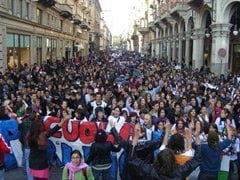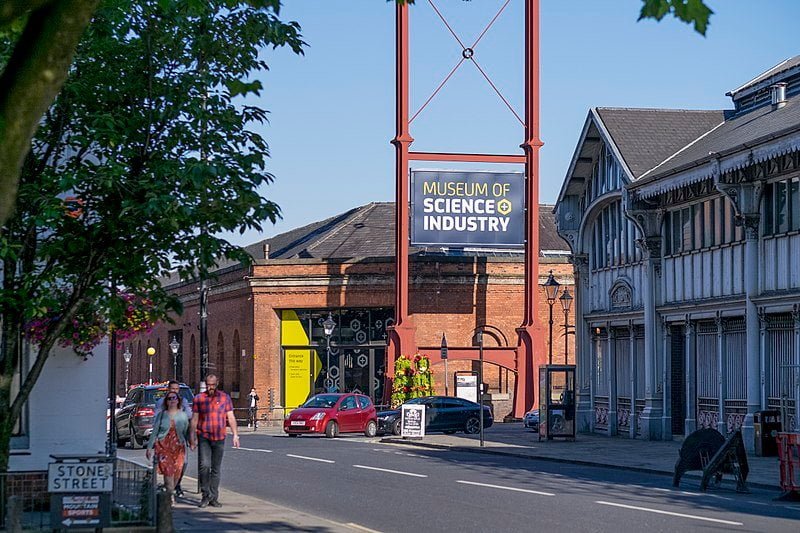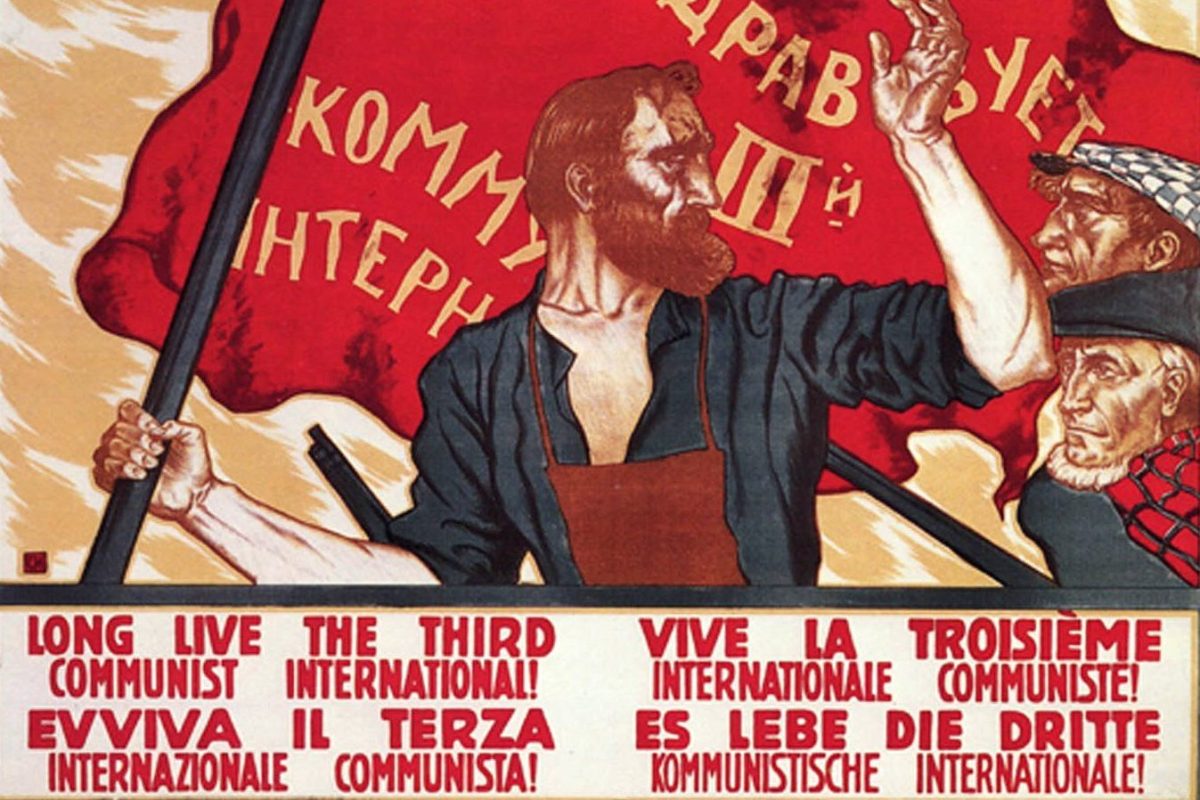There has been an explosion of anger among young people all over Europe. This anger is directed at hardline neoliberal policies aimed at privatising education and casualising youth employment. In a word they have been designed to make young people bear the burden of capitalism. The youth have been fighting back. This inspiring movement recalls memories of the pan-European movement of 1968. It could be bigger and more significant, as it coincides with a reawakening of the organised working class in the teeth of the crisis of capitalism.
Spain
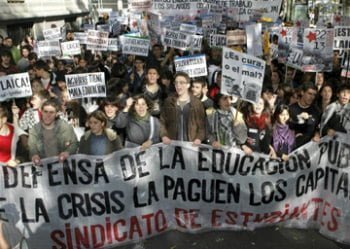 The Spanish Socialist Party government attempts to introduce the Bologna process – privatisation of higher education. In the case of Spain this would be accompanied for example by the replacement of student grants with student loans. This sparked of a huge movement of students, which resulted in two student strikes, both called by the Marxist-led Sindicato de Estudiantes (Spanish Student Union). On 22 October 96% of high school and secondary students and 70% of university students throughout the country responded to the first strike call. Tens of thousands took to the streets in demonstrations in up to 40 different towns and cities (with e.g. 10,000 in Madrid and 5,000 in Barcelona). The movement was also a response to the crisis of capitalism which has hit Spain harder than most countries. It is one of the countries where the housing bubble was one of the biggest, and has now burst. The productive sector is already affected, with thousands of jobs being threatened, while there are already about three million workers unemployed. The government is cutting money for education and health services, and at the same time is giving away 150 billion Euros to the bankers. The demonstrators demanded that the bankers and the rich should pay for the capitalist crisis and one of the main slogans of was “el hijo del obrero a la Universidad” (working class students to university).
The Spanish Socialist Party government attempts to introduce the Bologna process – privatisation of higher education. In the case of Spain this would be accompanied for example by the replacement of student grants with student loans. This sparked of a huge movement of students, which resulted in two student strikes, both called by the Marxist-led Sindicato de Estudiantes (Spanish Student Union). On 22 October 96% of high school and secondary students and 70% of university students throughout the country responded to the first strike call. Tens of thousands took to the streets in demonstrations in up to 40 different towns and cities (with e.g. 10,000 in Madrid and 5,000 in Barcelona). The movement was also a response to the crisis of capitalism which has hit Spain harder than most countries. It is one of the countries where the housing bubble was one of the biggest, and has now burst. The productive sector is already affected, with thousands of jobs being threatened, while there are already about three million workers unemployed. The government is cutting money for education and health services, and at the same time is giving away 150 billion Euros to the bankers. The demonstrators demanded that the bankers and the rich should pay for the capitalist crisis and one of the main slogans of was “el hijo del obrero a la Universidad” (working class students to university).
The Student Union made a conscious effort to link the movement of the students with that of the workers. This found its expression in trade union representatives and shop stewards addressing the different demonstrations. It also made a public appeal for trade unions to prepare a general strike to defend jobs and public services. This is quite contrary to the leadership of the main trade unions, UGT and CCOO, have already made statements to the effect that “we should all work together to overcome this crisis”.
The second strike took place on November 13. The percentage of participation in the strike was nearly the same as in the first strike, but this time the turnout for the demonstrations was even higher. Hundreds of thousands of students took part in more than 60 demonstrations across the country. The largest demonstration took place in Barcelona with 70,000 students and teachers, as in Catalonia the workers’ unions USTEC and CGT also called a strike of the teachers in schools and colleges. Also the Bus Drivers’ Strike Committee supported the students’ strike, as the Students Union supported the bus drivers in a successful struggle earlier this year. In Madrid about 30,000 students participated and trade unionists from the health service, the water supply company and the University workers addressed the demonstrators.
Germany
On 12 November, 100,000 school and university students in more than 40 cities all over Germany came out on to the streets to demonstrate against the advancing privatisation of schools and universities, and the continuous worsening of the education system. In many cities also teachers joined the protests. This turnout exceeded the expectations of the organisers, as in many cases the students had been intimidated beforehand.
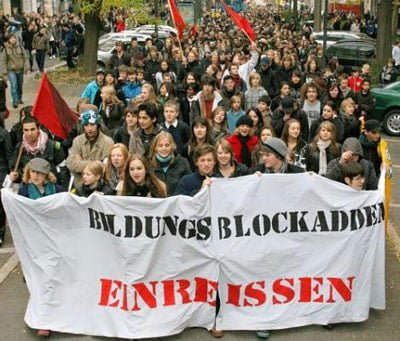 Earlier in May and June this year 40,000 students went on strike. As a consequence of these strikes student committees in different cities and a nationwide students’ action alliance was formed, which were in charge of planning and coordinating the strike actions. They were also seeking collaboration with trade unions, parties and different NGOs, many of whom declared their solidarity immediately.
Earlier in May and June this year 40,000 students went on strike. As a consequence of these strikes student committees in different cities and a nationwide students’ action alliance was formed, which were in charge of planning and coordinating the strike actions. They were also seeking collaboration with trade unions, parties and different NGOs, many of whom declared their solidarity immediately.
The strikers demanded free education for all (no to university and school fees), for the taking on of enough teachers in order to lower the number of students per class, no to a mark for behaviour and “cooperation” during lessons in the school report, no to private sponsoring and no to privatisation of the education system.
The situation in some schools is already dreadful. In some cases students have to pay for the maintenance of the classroom and for the paint out of their own pockets. Because of a shortage of teachers not only many lessons, but even whole school subjects, have had to be cancelled. The government is cutting millions of Euros from university funding and as a result some universities are on the verge of bankruptcy. In this environment it is not surprising that students and teachers have reached the limit of what they can take. In some cities the demonstrations had a very radical character, with students bursting through no-protest zones, occupying the schools, universities and local education authorities.
Just as we saw in Spain, many students have noticed how determined the German government is to cut spending on the education system, while at the same time it did not hesitate one moment to hand over 500 billion Euros of taxpayers’ money to the banks. Many carried placards with slogans like “Education instead of banks” and “Billions for the banks, but education is axed”.
Italy
Also the right-wing government in Italy is attempting to cut state funding to education on an unprecedented scale. Starting at the end of October a massive students’ and teachers’ movement unfolded. Students have occupied universities in Bologna, Cagliari, Florence, Milan, Rome, Naples, Pisa, Lecce, Padua, Turin, etc. In many universities normal lessons have been suspended and instead students were discussing the details of the planned counter-reform in “outdoor lessons” and mass assemblies, which were also used to discuss how to strengthen the movement. Mass demonstrations have been staged in Parma, Genoa, Bologna, Naples, Rome, Milan, Pisa, Cosenza, Catanzaro, Siena, Turin, L’Aquila, Venice, Sassari and in many other cities. Also Primary and middle schools were in turmoil and high-school students were on the barricades, many of them occupied their schools.
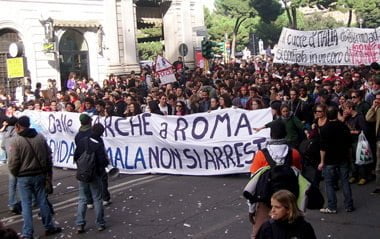 The struggle quickly spread to other layers of society. On October 30th a national strike of the school staff was called and on November 14th it was the turn of university personnel. Both strikes were a huge success and connected with the students’ mobilisations, becoming part of “The Wave” (l’Onda – official name of the students’ movement) and pushing other layers of workers and youth into action. Students, teachers, researchers and other workers were all together participating in the mass assemblies. Trade unions were co-operating with committees of teachers and parents in the organisation of the protests against the government. In Rome alone we saw a demonstration with more than one million people.
The struggle quickly spread to other layers of society. On October 30th a national strike of the school staff was called and on November 14th it was the turn of university personnel. Both strikes were a huge success and connected with the students’ mobilisations, becoming part of “The Wave” (l’Onda – official name of the students’ movement) and pushing other layers of workers and youth into action. Students, teachers, researchers and other workers were all together participating in the mass assemblies. Trade unions were co-operating with committees of teachers and parents in the organisation of the protests against the government. In Rome alone we saw a demonstration with more than one million people.
The reason for this broad support of the movement and the general discontent is clear: the deterioration which is on the way will hit everybody. State universities are to be privatised by transforming them into private foundations. The plan is to reduce the number of workers employed in the state education system, raising the size of classes and reducing the number of lessons, thus lowering the quality of state education. The demonstrators understood the link between these policies and the present crisis of capitalism. They wrote on their banners “We won’t pay for your crisis.”
Wider Movement
The rest of the working class is on the barricades as well. On September 27, the largest trade union confederation, the CGIL (with 5,600,000 members), called for rallies, demonstrations and sit-ins in all the main cities against the counter-reforms and the cuts being proposed by the Berlusconi government, namely against the weakening of the national collective wage bargaining system. On October 17, a coalition of minor left-wing trade unions organised a strike. The CGIL has been calling for a general strike on December 12: hundreds of thousands of workers and students were demonstrating in 100 different cities.
Unite!
There has been a movement of students and young workers against the CPE in France in 2006. The CPE was a proposed law to rewrite the first employment contract, designed to casualise youth employment and put young workers at the bosses’ mercy. Together with the movement which overrun Greece in December after the killing of a student (see pages 20-21), we could be witnessing here the beginning of a European-wide youth movement, not solely directed against deterioration in the education system. Many youth are now beginning to draw the necessary conclusions on how the capitalist system works: not for the millions who are willing to learn and educate themselves, but for the profits of a few companies, which are trying to exploit every corner of society in their greed for money.
At the same we saw this year a vast number of strikes of workers in Greece, Italy, Germany, Spain, Belgium and other countries. All this is an indication of the deep malaise and discontent within society, and it will erupt as a new wave of class struggle. What is required is to link the different struggles of the different layers in the different countries together. Last year we were celebrating the 40th anniversary of the 1968 movement, which was an inspiring example. But in the conditions of today, we could be facing in the not too distant future mobilisations of the youth and workers on a far vaster scale, on an all-European or even a world scale.

